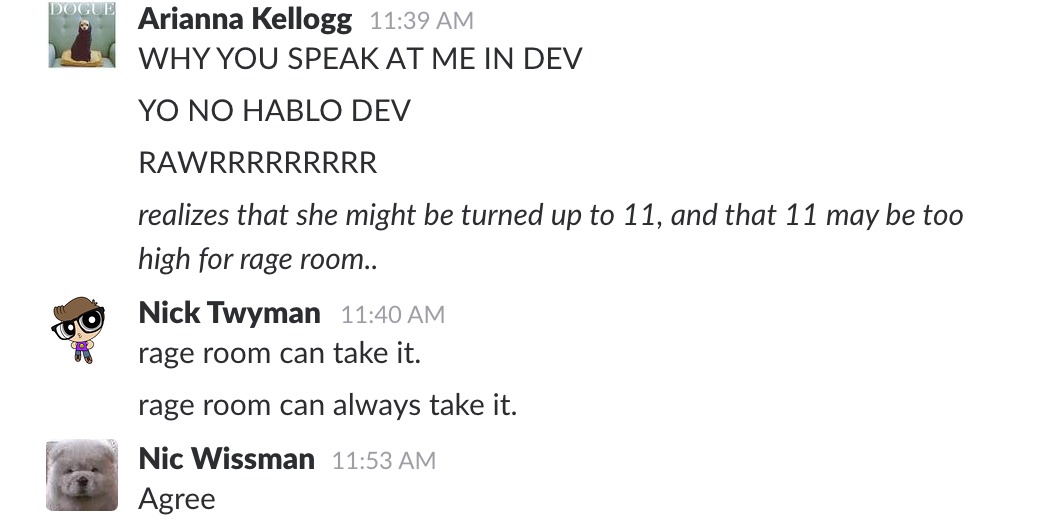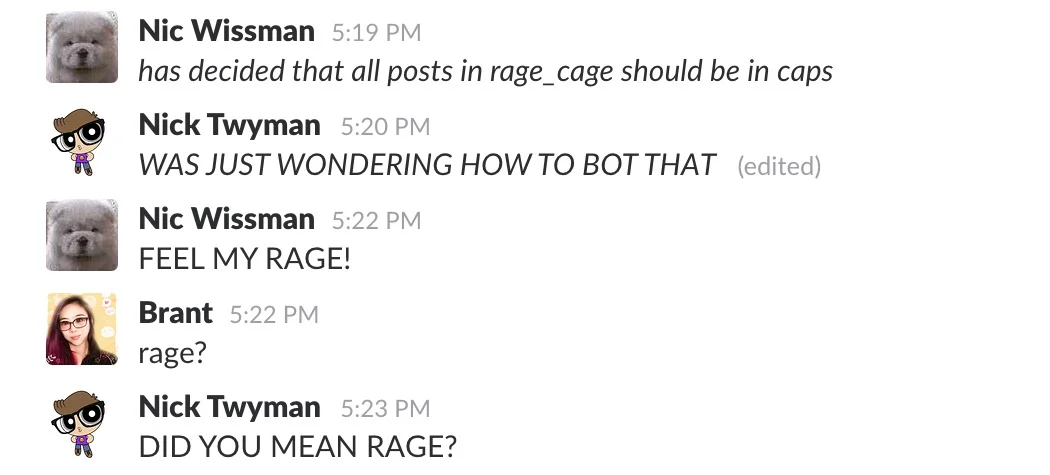Slack, Serendipity, and the #rage_cage
Here at Truss, we rely on Slack for internal communications. Like many other companies we prefer chat to email and Slack over Hipchat. We are a distributed consulting company which relies on chat to keep people informed, connected, and engaged.
Over time, our sense of how to best use Slack has evolved. Some of our innovations have proven much less useful than others; some took on a life of their own. This is the story of how we discovered that a default Slack setup should come with one additional channel that proved more vital than we imagined when it was created.
A bright shiny new Slack team setup contains a channel to which everyone is subscribed: #general.
It’s unlike all other Slack channels because no one can leave it — which is what makes it so useful! You don’t need to invite anyone to #general — they’ll be added automatically when they join the team. (Source)
In addition, there’s a second default channel: #random. As its name implies, it’s there for random conversations, things that you want to address to anyone who’s listening, but not for stuff of essential importance. The difference between #general and #random is the difference between “Payroll is running one day early this month, get your expenses in by the 14th” and “OMG check out this Corgi GIF!” Another important difference is that you can leave #random. If you don’t have time for the chatter, you can turn it off.
So far, so very common, and like many other companies I’m sure, our Slack channels grew from the original pair: channels for clients, channels for projects, channels for the office and games and… some thrived and some died. Natural selection at work.
Retrospectives
Among the predominant values of the culture at Truss are transparency, reflection, and candor. We try to be as honest, direct, and intentional as we can. To help that goal we hold periodic retrospectives based on the process described in the UK.gov digital service manual.
When we started out, having the entire company gather, reflect, and write up post-its which reflected their concerns and delights (both critical and petty) was an excellent way to surface issues we were too busy to address in the normal day-to-day work or patterns that only emerged when everyone got together and shared their experiences.
As we grew, however, the time spent gathering ideas and organizing post-its began to eat up the time set aside for the discussion of the issues raised. In addition, a number of people felt a lack of immediacy, having to wait for the next retrospective. This meant they forgot to bring things up when they were no longer proximate to the relevant event.
While discussing these things in one of our retrospectives, a couple of folks suggested that maybe we could use Slack to help. When things came up, people could drop a post in a Slack channel and the post would get added to the whiteboard come the next company retro.
Thus #retro_good and #retro_subpar were born: landing places for achievements we were proud of and pitfalls we would like to avoid.
Unexpected consequences
Like all new Slack channels, #retro_good and subpar started off relatively slowly but began to pick up steam. There were reflections on our use of Friday time (our day set aside for personal development).
And areas where we weren’t doing so well
Over time, however, something started to happen that we didn’t expect. Truss is a consulting company, and many of us are out with clients for much of the week. As a consequence we have not made spending money on ‘the office’ a high priority; in fact we rent space in a modern warehouse owned by friends of the company. The place has tons of character and tons of bugs (not literal bugs, the roach count is non-existent, but)--little issues like door handles not quite fitting.
What we noticed happening over a couple of months was that #retro_subpar began to be dominated by complaints about the office…
and these complaints seemed to feed off one another…
This all came to a head in a company retro during which Jamie, the Biz Ops Manager, was understandably frustrated that, no matter how hard he worked, he could never seem to make us happy. We were always griping about something in #retro_subpar.
As we pulled this apart during the retro, it became clear that people were using #retro_subpar not only to record issues that warranted group recognition and discussion, but also just to air gripes and expel momentary frustrations. A couple of people even suggested we should have a #catharsis channel or better yet #rage_cage. We didn’t think much of this at the time but agreed that we probably wanted to keep #retro_subpar to things worth holding on to and not cluttering it with the ephemeral frustrations of life.
An idea with a life of its own
Despite the fact that no-one had really picked up on it during the retro, I liked the idea of #catharsis and a couple of days later decided to set it up. As I didn’t grow up in the USA, the name #rage_cage hadn’t really resonated with me and, preferring alliteration to rhyme, I created #rage_room.
As happens with a new Slack channel, people wandered in and tried it out. They complained about silly things, they tested the boundaries …
and established social norms…
In particular, there were a couple of things that established the essential character of #rage_room; interestingly, both things had their seeds with a company founder.
First was the name and how it got fixed. I had mistakenly called it #rage_room, and there was some discussion the first day about how frustrating it was that it wasn’t called #rage_cage. Later that evening Jen, one of Truss’ founders, joined the room…
Notice the pause between Jen joining the room, catching up with the day’s posts and then responding. At work, Jen has a very focussed demeanor, not humorless by any means, but not gratuitous or wasteful. That “Done and done motherfuckers” had the air of a Zen Master making a point. If you’re gonna rage, do it properly.
The other essential aspect of #rage_cage was a slower burn, but again the tone was set by one of the Truss founders on the first day #rage_cage was around.
A silly, shouty post; a self consciously silly shouty post which turned out to be the first of many, until a week or so later.
And since then the #rage_cage has thrived as a silly, shouty, sweary place for people to vent. Rage is essentially silly in the sense of being pointless, shouty, and often sweary, but it is also essentially part of who we are.
A vital part of #rage_cage is that it is undirected and consensual. We do not moderate the language people use, but we never use #rage_cage as a forum for complaining about one another or the work we do. So far we have managed to give vent to the frustrations we saw in #retro_subpar without anyone feeling picked upon or criticized.
As I mentioned, we are a consulting company. We tend to work with customers who have enough of a problem that they can justify paying a consultancy to help them fix that problem. We are passionate about doing the best we can to make things better, but it can be frustrating, since we are dealing with companies and projects in extremis. Sometimes you just want to put it out there that you’ve had a shitty day; to do otherwise, to hide it or pretend all is good, would go against the transparency we value.
#GENERAL, #RANDOM, & #RAGE_CAGE
#retro_subpar & #retro_good have become much quieter since #rage_cage showed up. We still have issues we need to discuss and things we need to correct as a business, but they are far fewer than we often feel. As often as not we just need to yell a bit.
Where chat or e-mail lists have been adopted as a form of corporate communication, there has always been a space of some kind meant for everyone, the #general channel of Slack.
Very quickly, however, companies noticed that not everyone needs or wants to hear everything. Conversation, corgi gifs, and random chat are an important part of what brings us together as teams and communities of co-workers but are something you should be able to opt out of. Slack recognizes this by including #random in the channels you get by default when you set up a new team.
In #rage_cage, I think we have identified a third important part of this social exchange. Since setting up the #rage_cage, and in talking with others about it, we have discovered we are not alone in having a channel for this. Other channels we have heard about in this vein are #yelling and #scream.
A community really benefits from having space to let off steam, somewhere where you can rail absurdly and not to have to deal with someone else trying to fix or take on your problems. It is still importantly a social activity, a product of the community, but not necessarily one requiring a response. If you’re using Slack in your company, you might want to try adding some some flavor of #rage_cage.
P.S. We have reported an issue to Slack coming out of this. Slack insists that channel names are lowercase, as reflected herein. This is not normally a problem except when your channel really really should be called #RAGE_CAGE.










